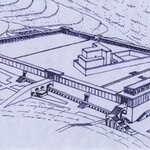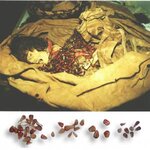Archaeology
Silver-bearing ore found at the settlement founded by Christopher Columbus's second expedition was not mined in the Americas, new research reveals.
Aerial view of La Isabela, the settlement established by Christopher Columbus's second expedition. Photo credit: J.M. Cruxent, Florida Museum of Natural History, University of Florida.
The ore that researchers excavated from the settlement, La Isabela, came from Spain, said Alyson Thibodeau, who analyzed the ores.
"What appeared to be the earliest evidence of European finds of precious metals in the New World turned out not to be that at all,"…

Hunting for traces of life on Mars calls for two radically different strategies, says Arizona State University professor Jack Farmer. Of the two, he says, with today’s exploration technology we can most easily look for evidence for past life, preserved as fossil "biosignatures" in old rocks.
Farmer is a professor of geological sciences in ASU’s School of Earth and Space Exploration, where he heads the astrobiology program. He is reporting on his work today (Feb. 16) at the annual meeting of the American Association for the Advancement of Science in San Francisco.
"Searching for…

Modern human mothers are probably happy that they typically have one, maybe two babies at a time, but for early hominids, low birth numbers combined with competition often spelled extinction.
"The lineages of primates have some traits that make it hard for them to respond to rapid perturbations in the environment," says Dr. Nina G. Jablonski, professor of anthropology and department head at Penn State. "Through time we see a lot of lineages become extinct when environments where the species are found become highly seasonal or unpredictable."
Primates evolved in the Paleocene and Eocene…

What caused the extinction of the woolly rhinoceros ten thousand years ago from an area in Europe covering the coasts of the Arctic Ocean in the north to the coasts of the Mediterranean in the south? What caused the extinction of the mammoth while other ice age mammals like the musk ox just barely survived to present day? A new scientific methodological approach to detect genetic material will help researchers to solve the many mysteries of the past.
"I'm confident that the new methodological approach, will be of great importance to molecular biology", says Professor Eske Willerslev at the…

While scholars have put forth various assessments for the location of the Second Temple in Jerusalem, a Hebrew University of Jerusalem professor says that archaeological remains that have so far been ignored by scholars point to the exact location, which is in a spot that differs from prevailing opinion.
The location identified by Prof. Joseph Patrich of the Hebrew University Institute of Archaeology places the Temple and its corresponding courtyards, chambers and gates in a more southeasterly and diagonal frame of reference than have earlier scholars.
Drawing (Temple1) shows Prof. Patrich’…

A University of Calgary archaeologist has found the first prehistoric evidence of chimpanzee technology, adding credence to the theory that some of humanity's behavioral hallmarks were actually inherited by both humans and great apes from a common ancestor.
Dr. Julio Mercader, one of the few archaeologists in the world who studies the material culture of great apes, especially chimpanzees, uncovered stone 'hammers' last year in the Taï rainforest of Africa's Côte D'Ivoire (Ivory Coast) that date back 4,300 years.
Examples of some of the stones that were excavated. Analysis shows they were…

The far-reaching influence of Spanish and Portuguese colonisers appears not to have extended to South American agriculture, scientists studying a 1,400-year-old Andean mummy have found.
The University of Manchester researchers compared the DNA of ancient maize found in the funerary offerings of the mummy and at other sites in northwest Argentina with that grown in the same region today.
Surprisingly, they found both ancient and modern samples of the crop were genetically almost identical indicating that modern European influence has not been as great as previously thought.
Photograph of the…

Excavations supported by National Geographic at Durrington Walls in the Stonehenge World Heritage site have revealed an enormous ancient settlement that once housed hundreds of people. Archaeologists believe the houses were constructed and occupied by the builders of nearby Stonehenge, the legendary monument on England's Salisbury Plain.
Stonehenge, Wiltshire. (Credit: Frédéric Vincent, March 2004)
"English Heritage's magnetometry survey had detected dozens of hearths -- the whole valley appears full of houses," said archaeologist Mike Parker Pearson of the U.K.'s Sheffield University. "In…

After the skeletal remains of an 18,000-year-old, Hobbit-sized human were discovered on the Indonesian island of Flores in 2003, some scientists thought that the specimen must have been a pygmy or a microcephalic -- a human with an abnormally small skull.
Not so, said Dean Falk, a world-renowned paleoneurologist and chair of Florida State University's anthropology department, who along with an international team of experts created detailed maps of imprints left on the ancient hominid's braincase and concluded that the so-called Hobbit was actually a new species closely related to Homo sapiens…

A University of Florida-led study has determined that Titanis walleri, a prehistoric 7-foot-tall flightless “terror bird,” arrived in North America from South America long before a land bridge connected the two continents.
UF paleontologist Bruce MacFadden said his team used an established geochemical technique that analyzes rare earth elements in a new application to revise the ages of terror bird fossils in Texas and Florida, the only places in North America where the species has been found. Rare earth elements are a group of naturally occurring metallic elements that share similar…